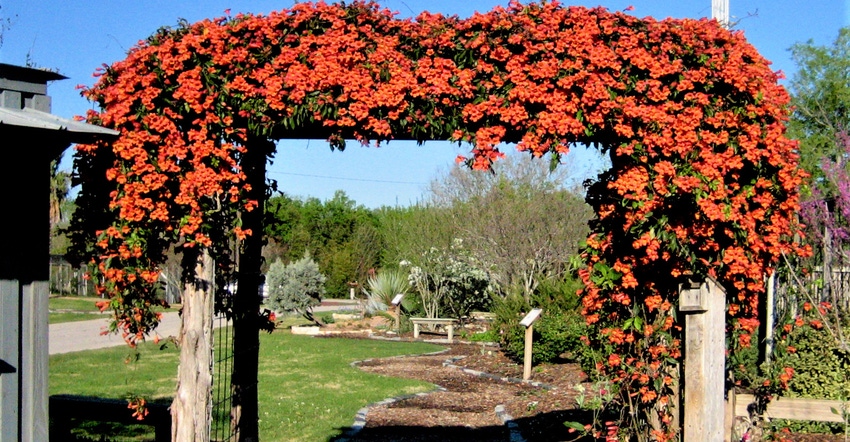
Tangerine Beauty crossvine, a native Texas vine with showy trumpet-shaped blooms and evergreen foliage, has been named the newest Texas Superstar plant.
Tangerine Beauty is known as crossvine due to the pattern inside its crosscut stem. It is a spring-blooming evergreen vine native to Texas and the southeastern U.S.
Greg Grant, Texas A&M AgriLife Extension Service horticulturist, Smith County, said Tangerine Beauty’s namesake color is much showier than its native relative, trumpet creeper, that sports banana-yellow tubular flowers with maroon highlights. There are also selections of crossvine with colors ranging from orange to red.
The plant scatters repeat blooms throughout the growing season and is a favorite among native Texas pollinators, including ruby-throated hummingbirds.
“Tangerine Beauty is the showiest and most widely available among the crossvine cultivars,” Grant said. “You can’t avoid paying attention to it, and the bigger it gets, the more spectacular it can be.”
To be designated a Texas Superstar, a plant must perform well for growers throughout the state. Texas Superstars must also be easy to propagate, ensuring the plants are widely available and reasonably priced.
Discovering Tangerine Beauty
Tangerine Beauty was discovered growing in a garden in San Antonio by Texas horticulturist and garden writer Scott Ogden in the 1980s. It was subsequently named and introduced by the North Carolina State Arboretum in 1993.
 Tangerine Beauty provide evergreen screening foliage to go with its eye-catching blooms. (Texas A&M AgriLife photo by Mike Arnold)
Tangerine Beauty provide evergreen screening foliage to go with its eye-catching blooms. (Texas A&M AgriLife photo by Mike Arnold)
Tangerine Beauty was promoted and gained wider fame after it landed on the cover of American Nurseryman, Grant said. It has since become a standard for vining applications in landscapes.
It is a vigorous clinging vine that is ideal for trellises, fences, arbors and brick or rock walls, Grant said. The heaviest blooms occur when plants receive full sun. However, Tangerine Beauty will tolerate moderate to dense shade.
The plant can easily grow to 15-20 feet tall and wide, Grant said. It does shed leaves, but its evergreen foliage makes good covers and screens and provides permanent shade.
“Giving it space to grow where you want it to cover or climb is the main consideration with Tangerine Beauty,” he said. “Any stone, brick or metal structures are great, and wood is fine, but homeowners need to remember that moisture around the plant and shed leaves can cause issues for wooden structures long-term.”
Planting and care
Grant said the Tangerine Beauty is hardy to Zone 6, and its native characteristics make it well-adapted to most situations. Container-grown plants can be planted year-round.
Well to moderately drained soils are best, but plants are adapted to a wide range of pH levels and soil types, including sand, silt or clay, Grant said. They will tolerate low fertility locations, but they do grow more vigorously where adequate nutrients are available.
Grant said Tangerine Beauty is ideal for any landscape, particularly Earth-Kind, native, organic, pollinator and wildscape gardens.
“It doesn’t need protection with fungicides or pesticides and does well in dry conditions, though it may require some watering in extreme drought,” he said. “But otherwise, it is low maintenance and needs very little other than space to grow.”
Texas Superstar is a registered trademark owned by Texas A&M AgriLife Research. Plants are designated by the Texas Superstar executive board, which comprises nine horticulturalists from AgriLife Research, AgriLife Extension and Texas Tech University.
Source: is AgriLife TODAY, which is solely responsible for the information provided and is wholly owned by the source. Informa Business Media and all its subsidiaries are not responsible for any of the content contained in this information asset.
Read more about:
FlowersAbout the Author(s)
You May Also Like




